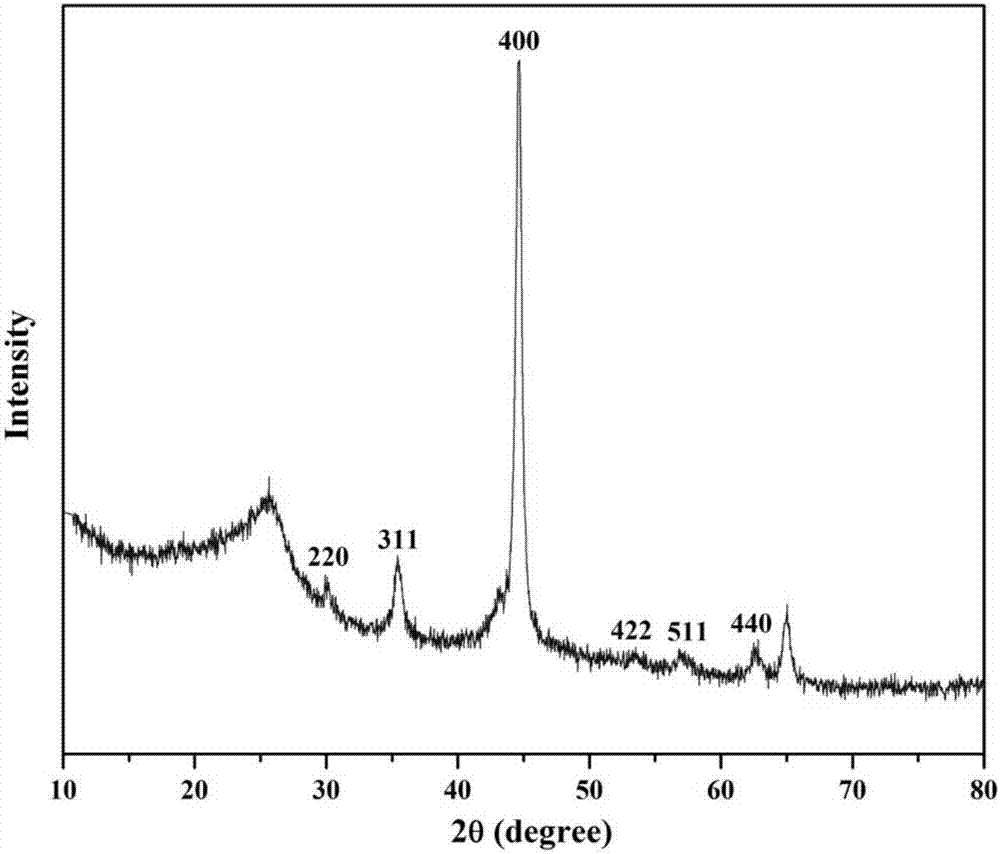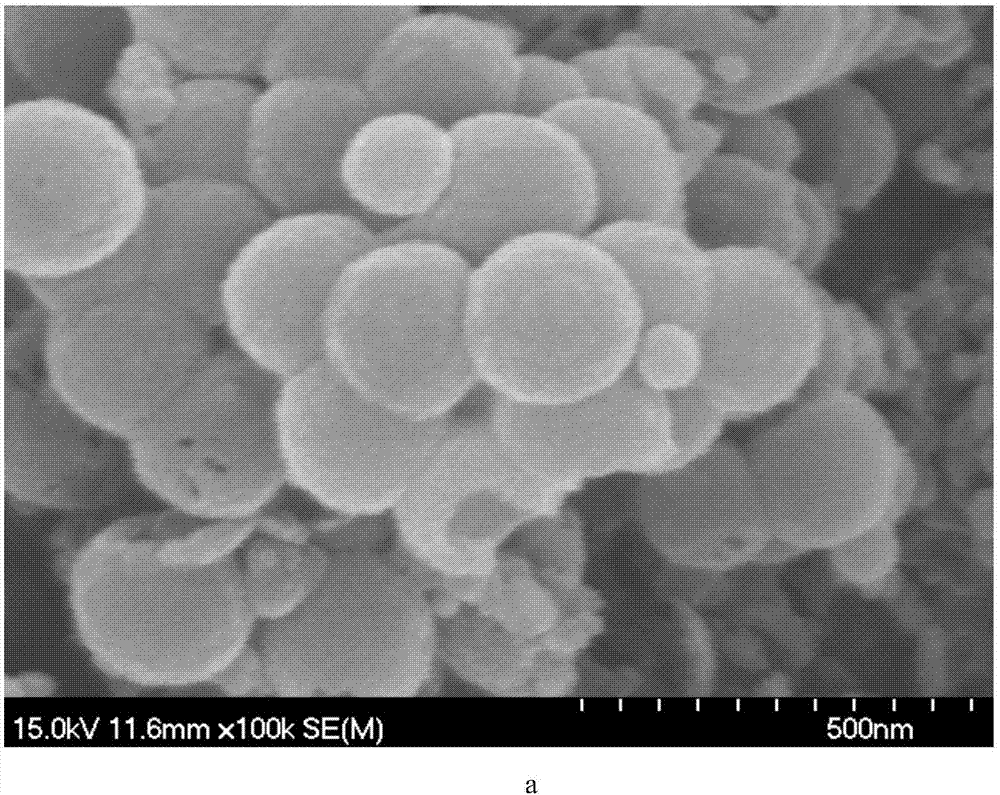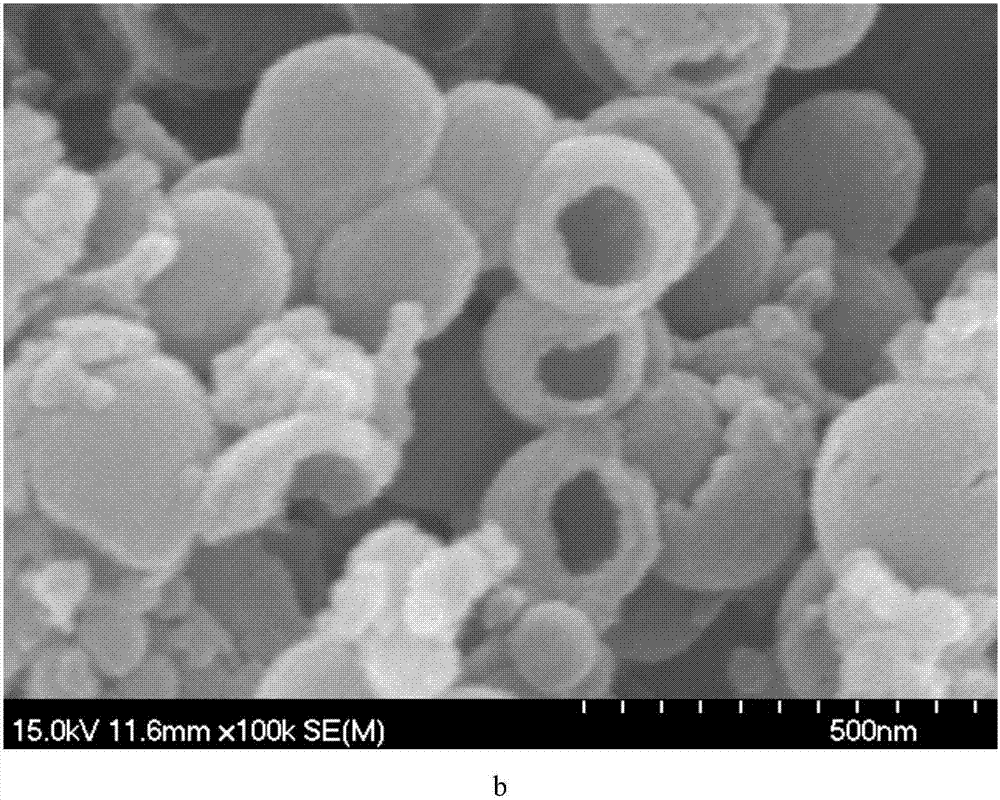CoFe2O4/N/C hollow nanosphere and preparation and application thereof
A hollow nanometer and nanosphere technology, applied in water/sludge/sewage treatment, other chemical processes, water/sewage treatment, etc., can solve the problems of difficult recycling of catalysts, large amount of metal ion leaching, and low catalytic efficiency. , to achieve the effect of being beneficial to secondary utilization, improving catalytic efficiency, enhancing adsorption and catalytic activity
- Summary
- Abstract
- Description
- Claims
- Application Information
AI Technical Summary
Problems solved by technology
Method used
Image
Examples
Embodiment 1
[0036] Example 1: CoFe 2 O 4 / N / C Hollow Nanosphere
[0037] (1) SiO 2 Preparation of nanospheres: add 2.6 mL of tetraethyl silicate, 108 mL of ethanol, 5 mL of deionized water, and 5 mL of ammonia (mass concentration 25%) into an Erlenmeyer flask, stir vigorously at room temperature for 12 hours, centrifuge, and wash with ethanol 3~5 times, vacuum drying at 80℃ to obtain SiO 2 Nano microspheres are 400mg, with a particle size of 150nm.
[0038] (2) Put 150mg SiO 2 Nanospheres were added to 150mL deionized water, after ultrasound, 150mg dopamine, 17.5mg Co(NO 3 ) 2 ·6H 2 O and 23.88mg FeCl 2 ·4H 2 O, adjust the pH to 8.5 with Tris-HCl buffer, start the reaction, mechanically stir at room temperature for 18 hours, rotate at 1300 rpm, and collect the black precipitate by centrifugation, wash with deionized water for 2 to 3 times and then vacuum dry at 80°C to obtain black particles 234mg.
[0039] (3) Put the black particles obtained in step (2) into a tube furnace in an argon atmosph...
Embodiment 2
[0045] CoFe prepared in Example 1 2 O 4 / N / C hollow nanospheres are used as heterogeneous Fenton-like catalysts to degrade wastewater containing 20mg / L cationic dye methylene blue. The degradation experiment was carried out in a 250ml Erlenmeyer flask. In 100ml wastewater, the final concentration of catalyst dosage was 0.1g / L based on the volume of wastewater, and the dosage of permonosulfate (PMS) was 0.8g / L based on the volume of wastewater. L, oscillate the reaction at 25°C and 250 rpm to mix the catalyst and the solution uniformly, take out the reaction solution from the reaction system at a certain interval, and measure the change of methylene blue concentration with the reaction time. CoFe 2 O 4 / N / C hollow nanosphere type heterogeneous Fenton-like catalyst for degradation of methylene blue Figure 4 Shown. Under the same conditions, the simulated wastewater + catalyst and simulated wastewater + PMS were used as controls.
[0046] From Figure 4 It can be seen that only u...
Embodiment 3
[0048] The material synthesized in step (3) in Example 1 was used as a catalyst for catalytic activity test, and the reaction conditions and steps were the same as in Example 2. The results showed that only 52% of the methylene blue was removed within 20 minutes, indicating that CoFe 2 O 4 The hollow configuration of the / N / C hollow nanosphere catalyst plays an important role, greatly improving the catalytic degradation efficiency of the catalyst.
PUM
| Property | Measurement | Unit |
|---|---|---|
| particle diameter | aaaaa | aaaaa |
| size | aaaaa | aaaaa |
Abstract
Description
Claims
Application Information
 Login to View More
Login to View More - R&D
- Intellectual Property
- Life Sciences
- Materials
- Tech Scout
- Unparalleled Data Quality
- Higher Quality Content
- 60% Fewer Hallucinations
Browse by: Latest US Patents, China's latest patents, Technical Efficacy Thesaurus, Application Domain, Technology Topic, Popular Technical Reports.
© 2025 PatSnap. All rights reserved.Legal|Privacy policy|Modern Slavery Act Transparency Statement|Sitemap|About US| Contact US: help@patsnap.com



